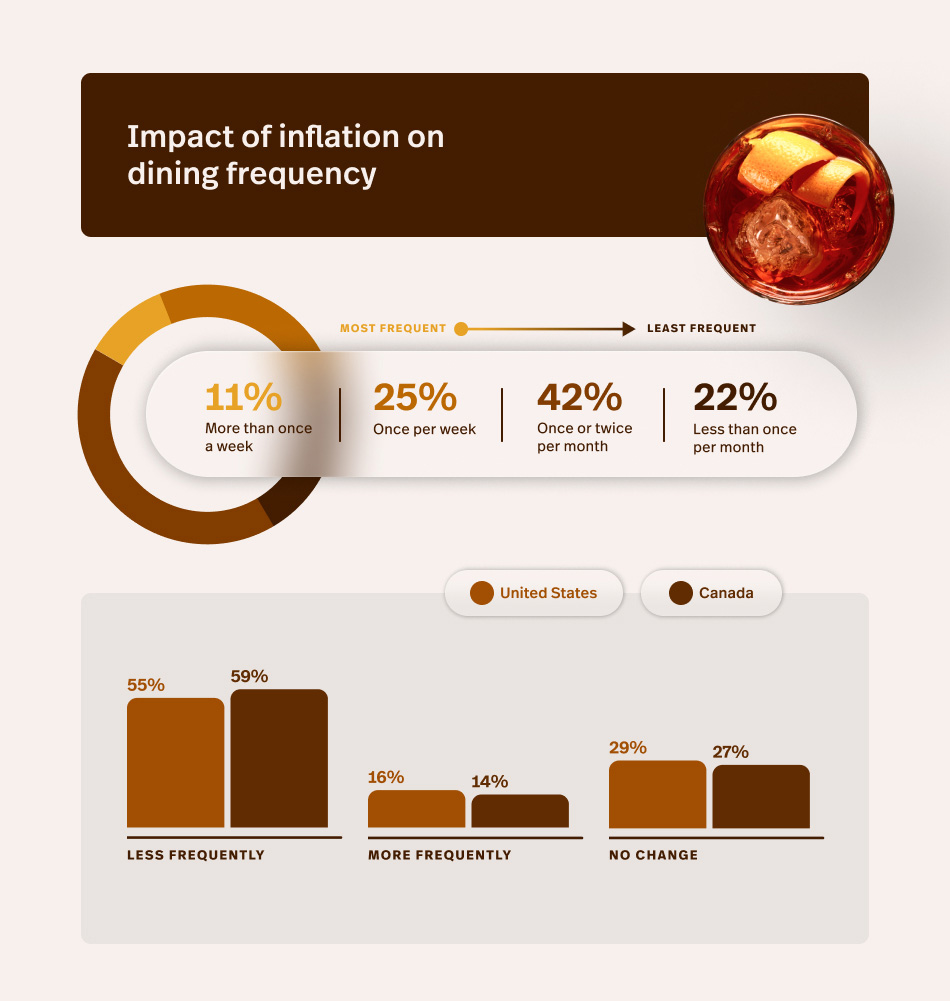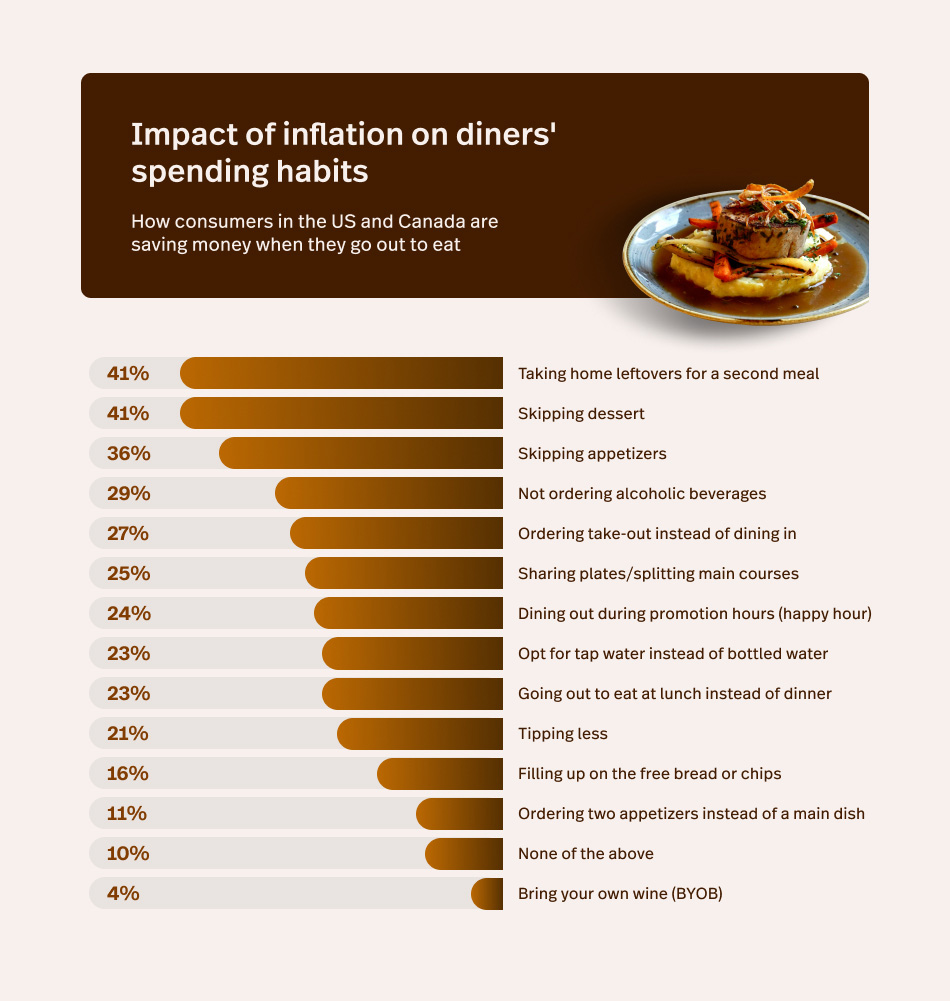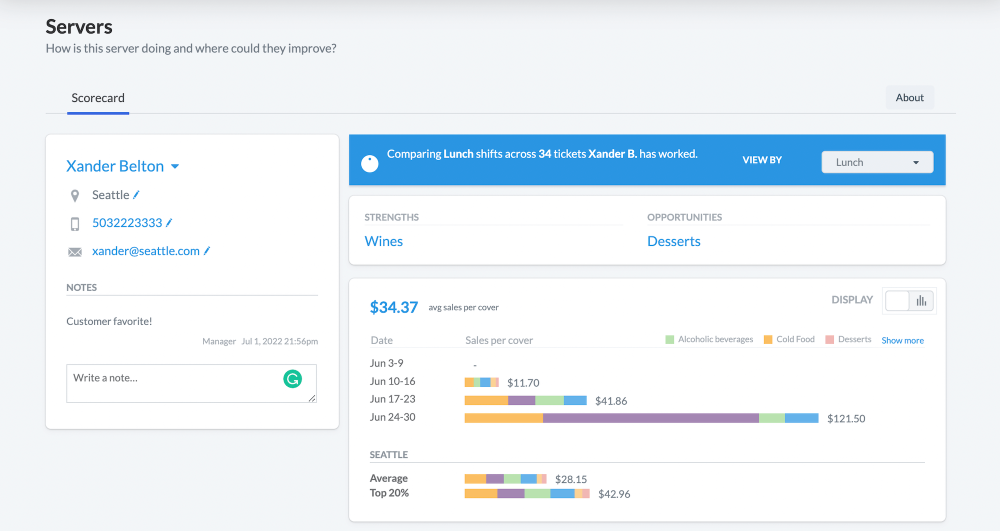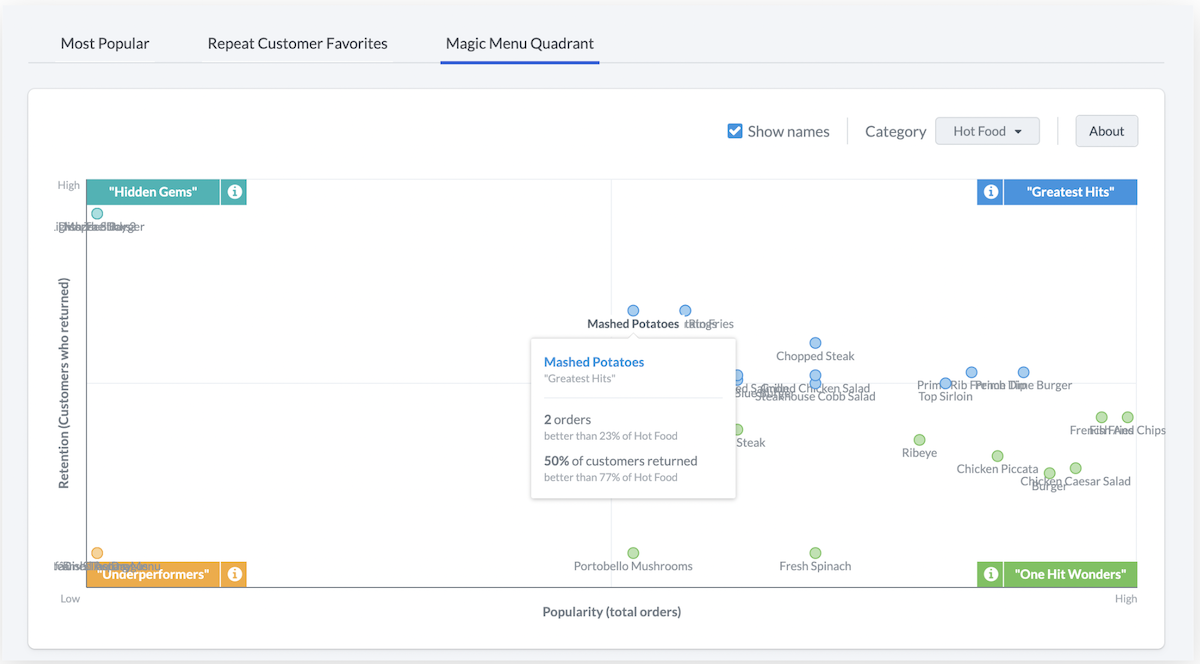
Lightspeed’s 2024 State of Hospitality report is an in-depth analysis designed to shed light on the evolving landscape of the hospitality industry. Based on a survey of more than 7,500 dining consumers globally—with 3,000 respondents in Canada and the United States—this year’s report places a significant emphasis on how inflation is reshaping dining habits.
The report highlights the various methods diners are using to save money when they go out for a meal. These trends indicate a broader move towards more cost-conscious dining decisions, driven by the economic realities faced by both consumers and restaurateurs.
With this report, Lightspeed aims to empower restaurateurs with the insights they need to counter inflation and its effects on their business—including understanding how consumer behavior is changing and how they can adapt their own behavior to better navigate current economic conditions. The data presented here represents survey data collected from respondents in the US and Canada.
Impact of inflation on dining frequency

We’ve got good news for restaurants: despite tighter household budgets forcing many consumers to dine out less frequently, 74% of Canadians are still going out at least once a month, with 31% dining out once a week or more. Numbers are even rosier in the US, with 81% of Americans dining out at least once a month and 39% once a week or more. 48% of all respondents said they will either continue to dine out at the same rate, or increase going out in the next six months.
That being said, consumers are looking at how best to stretch their dollar, as seven in ten (69%) diners report higher meal prices, and four in ten (40%) notice their favorite dishes are shrinking in size—a phenomenon commonly referred to as ‘shrinkflation.’
Impact of inflation on diners’ spending habits
While the majority of diners haven’t cut back on how often they indulge in their favorite pastime, inflation has significantly impacted spending per visit. Menu price hikes, combined with the overall increase in the cost of living, has led consumers to adopt more budget-conscious behaviors when they go out for a meal.
In response to restaurant inflation, many consumers are opting for less expensive menu items, skipping extras such as appetizers, desserts and alcohol, and taking advantage of promotions and loyalty programs to mitigate higher costs.
Out of 3,000 respondents in Canada and the US, only 300 diners (10%) aren’t doing anything to save money this year when they go out to a sit-down restaurant. This shift in behavior reflects a broader trend of consumers adjusting their spending habits to cope with economic pressures.
Restaurant closures and their effects
Rising costs of food, rent, labor, utilities and debt have put substantial financial pressure on restaurants, making it harder than ever to be profitable. Many establishments, particularly independent restaurants and restaurant groups, have been unable to absorb these costs, leading to a wave of closures across Canada and the US.
As cost increases outpace restaurateurs’ ability to adjust menu prices without deterring customers—also feeling squeezed by “cost of living creep”—restaurants are finding themselves in a precarious position. Unfortunately for everyone, many have been unable to balance rising costs with the need to keep prices competitive.
And when we say unfortunate for everyone, we do mean everyone. Because besides being important social hubs, restaurants are a key employer in their neighborhood and play a fundamental role in the local economy. An increase in closures impacts everything from local tourism to municipal tax revenue and property values. They’re also a crucial part of the social fabric; they breathe life into a community and play an important role in reflecting its character and charm.
Consumer strategies for saving money

Savvy diners in Canada and the US are using various strategies to save money when they go out to eat at restaurants. Here’s an overview of some of the most common:
- skipping courses and/or alcohol
- taking advantage of promos, discounts and loyalty programs
- taking home leftovers
- sharing plates or splitting a main
- saving money on service fees with takeout and delivery
- tipping less
Skipping apps, desserts, and/or alcoholic beverages
To reduce the total bill, many diners are skipping appetizers (36%), dessert (41%), and alcohol (29%), which can significantly increase the cost of a meal. Instead, they’re focusing on the main course (83%), swapping bottled water and fountain pop for tap water (23%), and filling up on free bread or chips (16%).
Taking advantage of promos, discounts and loyalty programs
A whopping 79% of all respondents are taking advantage of cost-saving promos to keep costs under control despite restaurant inflation. These were the most popular among all respondents:
- coupons/discounts (42%)
- value meals and combos (37%)
- happy hour specials (32%)
- loyalty programs (31%)
- seasonal promos or themed events (28%)
Taking home leftovers
Bad news for your takeout supplies budget: it looks like restaurant inflation is bringing back doggy bags. Nearly half (45%) of US respondents are not shy about asking to box up their food to make every dollar count, compared to 36% of respondents in Canada. Interestingly, 53% of women compared to 38% of men are more likely to enjoy a second meal with the leftovers. Americans aged 55+ are similarly inclined, with 53% taking doggy bags home.
Sharing plates or splitting a main
Another popular strategy diners are using against restaurant inflation is sharing plates or splitting an entrée. 25% of respondents said they’ve been relying on share plates or splitting mains to reduce their individual spending while still enjoying a restaurant-quality meal.
Saving money on service fees with takeout and delivery
More consumers are turning to takeout and delivery (27%) that offer lower service fees compared to dining in, allowing them to enjoy restaurant-quality food at home without the added costs associated with eating out. Even with delivery fees and driver tips taken into account, respondents still say they save money when they order-in compared to what they expect to pay in a restaurant dining room.
Tipping less
Inflation has affected the amount US diners are willing to tip, according to 44% of survey respondents and more than half (55%) in the 18-34 age group. That being said, the majority of American restaurant-goers remain generous tippers, with 37% tipping between 16-20%, and 13% tipping 21% and above.
Canadian respondents, on the other hand, seem to have reached their tipping point. While 67% feel more pressure to tip, 53% say inflation has affected their ability to do so and 25% are tipping less when they go out for a meal. A whopping 77% of Canadian diners are not fans of auto-tipping prompts on digital screens.
Interestingly, 34% of Canadians want to see tipping eliminated altogether, compared to only 25% of Americans, and most of those (31%) would be willing to pay higher prices for their meal if it meant they didn’t have to tip.
How restaurants can adapt
To combat the effects of inflation, restaurants can implement several strategic measures to maintain profitability and customer satisfaction. For best results, restaurateurs will want to take a holistic approach, considering all aspects of their operations from menus to customer engagement.
Menu strategies
Menu engineering is one of the most powerful tools in the restaurateur’s toolbelt. And we’re not just talking about increasing prices. Here are 10 ways you can adjust your menu to save costs and counter the effects of restaurant inflation without hiking prices:
- Simplify your menu. Reducing the number of items on your menu can streamline kitchen operations and reduce food waste, helping you to save on costs without compromising quality. For example, with Lightspeed’s Magic Menu Quadrant, you can easily identify popular menu items that make money and/or have good margins vs dead weight that’s just weighing you down.
![Scatter chart with menu items organized into 'hidden gems', 'greatest hits', 'one hit wonders' and 'underperformers']()
- Experiment with cheaper ingredients. Depending on your concept, you may want to swap out the pricier ingredients with a more affordable alternative. For example, if you’re not a fine dining establishment or fancy cocktail bar, will your customers notice if you swap the Cointreau in your Cosmopolitan for Triple Sec?
- Experiment with cheaper cuts of meat. Cheaper cuts of meat like pork shoulder and organ meat are on trend and come out perfectly when prepared in the right way. So why not give your menu the oxtail treatment? Show your customers what you can do with “throwaway” cuts that have enormous potential in the right hands.
- Experiment with different proteins. Plant-based proteins aren’t just cheaper to buy, they’re an increasingly popular choice among diners of all demographics. Because yes, there are more vegans and vegetarians in the world, but even die-hard carnivores are opting for plant-based foods for health and environmental reasons.
- Evaluate your portion sizes. Be careful with this one, as 40% of respondents have noticed and aren’t thrilled about shrinkflation. That said, it’s still a good idea to look at your portion sizes, not just to save money but also to reduce food waste. Your servers and bussers can offer valuable insights on this one.
- Use menu psychology. There’s a lot that you can do with menu design that can noticeably impact your bottom line. Everything from layout to color to eye movement patterns can be manipulated to gently nudge customers towards more profitable menu items. Learn more about menu engineering.
- Consider flexible or tiered pricing. Let customers choose from different price points for a particular item based on portion size or ingredients, such as a ½ portion of a main or the “poor man’s Cosmopolitan” we discussed above.
- Get diners in the door with discounts and value-adds. Offering limited-time discounts, bundles or promotions can help you counter the effects of inflation on your restaurant by attracting even the most cost-conscious customers. By giving them more bang for their buck, you can increase their total bill while ensuring they leave happy.
- Introduce affordable luxuries. Let diners treat themselves with menu items that feel luxurious but don’t break the bank (for you, or for them). For example, truffle fries or gruyère-laced popcorn.
- Consider introducing a nominal split plate charge. One table splitting a main isn’t a big deal, but a dining room full of customers sharing one plate could be seriously problematic. As this practice gains in popularity, you may want to consider a small split plate fee to both mitigate the impact of this cost-saving strategy on your bottom line and steer guests toward better options. If you go this route, be sure to:
- Clearly communicate this on the menu and to your staff so that customers are aware of the charge upfront.
- Coach your service staff on how to communicate this charge and handle any objections courteously yet assertively.
- Provide training on how to steer guests away from splitting a main to something like a small plate bundle or ½ portions if you offer them.
- Justify the charge with a little extra effort. Something as simple as splitting the meal onto two plates could be enough to pacify guests who may be feeling salty about the additional fee.
Operational strategies
Effective operational strategies can help restaurants better manage costs and improve efficiency. Here are five ways you can transform your operations to help counter inflation in your restaurant:
- Implement strict inventory controls to minimize waste and spoilage. Regularly auditing inventory and using advanced inventory software to track stock levels can prevent over-ordering and ensure ingredients are used before they expire. It can even help deter employee theft, which costs the food industry $3 to $6 billion a year.
- Optimize your schedule with better forecasting tools. Use your historical data to plan your schedule based on demand, ensuring that you have enough staff during busy times without overstaffing during slower periods. This will pay huge dividends when it comes to your labor budget. Just ask this Toronto-based speakeasy that slashed $400-500/week off their labor costs when they integrated 7shifts scheduling software with Lightspeed Restaurant POS.
- Run staff training on suggestive selling and upselling. Train staff to cross-sell and upsell in a way that bumps up the average check without coming across as pushy. With restaurant inflation-weary diners more hesitant to spend, it’s more important than ever for front of house staff to be knowledgeable and adept at selling to keep the restaurant in the black. With staff performance data like Lightspeed’s server scorecards, restaurant owners and managers can identify their top sellers and the skills gaps they need to address to build a stronger team. Learn more about Lightspeed’s Advanced Insights.

- Leverage technology to drive more delivery and takeout sales. More than a quarter of respondents (27%) are ordering more takeout and delivery—you want a piece of that pie. To maximize your takeout and delivery offering, ensure that your delivery workflow is streamlined to avoid inefficiencies that could slow down service or lead to errors.
- Ensure that your delivery software integrates seamlessly with your POS to avoid manual data entry and reduce the risk of human error. Decide whether to handle delivery in-house or use a third-party service. Each option has its pros and cons, so consider what’s best for your business.
- If your delivery service is already well-established, consider a white-label solution for fast, reliable local delivery. For example, thanks to a partnership with Uber Direct, Lightspeed empowers merchants to tap into Uber’s world-class courier network on demand—with 0% commission. Learn more about flexible and on-demand delivery.
- Use dynamic pricing to get people into your restaurant during off-peak hours. Offer discounts or special deals like happy hour specials during times when business is typically slower to attract more customers and increase revenue. Leverage the data and reports in your restaurant point of sale to pinpoint what you should offer and when.
Customer engagement, communication & marketing strategies
Engaging with your customers through effective marketing and communication strategies is crucial in adapting to the pressures of restaurant inflation. Here are five customer engagement and marketing strategies to steal:
- Engage your marketing list and social network with promos and bundle offers. Regularly send out emails or SMS messages to customers on your subscriber list featuring limited-time promotions, special bundle deals and discounts to entice them back in the door. Leverage social media to increase your reach and get customers to engage with your brand. Download our Advanced Marketing Guide for more restaurant marketing tips.
- Enhance your loyalty programs. Implement points-based rewards and offer other perks like invitations to special events, exclusive discounts or invitations to special events to make loyal customers feel valued and keep them coming back.
- Get involved in the community. Considering partnering with local businesses for cross-promotions or special events to attract more customers. You could also host a community event or charity night where a portion of proceeds goes to a local non-profit.
- Clearly communicate the value of what you have to offer. Highlight the quality of your ingredients, the expertise of your chefs and the unique dining experience you provide. Use your website, social media and in-restaurant signage to tell customers why dining with you is worth every penny.
- Be honest and transparent. If you have to raise prices in your restaurant to deal with inflation, tell your customers why. Something as simple as a statement on your menu or guest receipts can go a long way. Provide coaching and talking points to staff so they feel comfortable having open and honest conversations with guests about price increases.
Key takeaways
The Lightspeed 2024 State of Hospitality report provides a detailed look at how restaurant inflation is changing dining habits in North America. Despite financial pressures, many consumers continue to dine out regularly but are adopting more frugal behaviors. This shift towards frugality reflects broader economic realities, with only a small percentage of diners not taking any steps to save money when eating out.
The report also underscores the impact of ongoing inflation on restaurants, which has led to numerous closures that affect local economies and communities. To counter inflationary pressures, restaurants should look to adjust their menu strategies, operations and customer engagement strategies to stay profitable despite restaurant inflation.
Lightspeed provides innovative technology and market-leading insights to help restaurateurs move faster, stay agile and adapt to changing customer behaviors. We’re the preferred technology partner for some of the world’s best restaurants. But don’t just take our word for it—find out what our customers have to say.
Want to learn what Lightspeed can do for your business? Watch a demo here.

News you care about. Tips you can use.
Everything your business needs to grow, delivered straight to your inbox.



